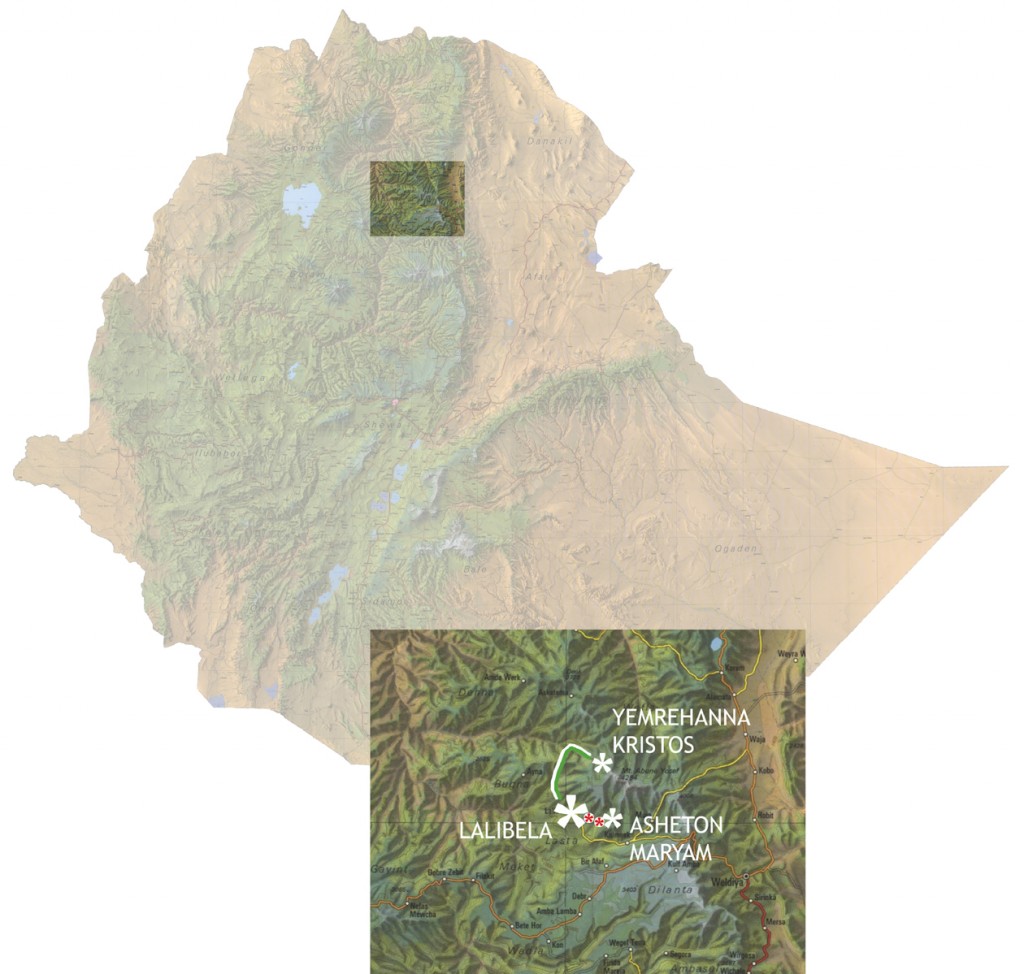Lalibela is situated amongst breathtaking landscape at an altitude of 2,630 metres. Yet the city came to prominence because of its great cultural heritage, which in 1978 was declared a UNESCO World Heritage Site.
During the reign of King Lalibela in the 12th and 13th centuries, eleven rock-hewn churches were erected in the city that shared both his residence and his name, painstakingly carved from the rock foundations of the town. All eleven churches are monolithic, in that they were created out of one continuous piece of rock. The position of each church is particularly interesting as each is located below ground level, built into the depths of the stone. The buildings reach heights of ten metres or more making them a most impressive site. Most churches are free-standing structures, centred within a deep courtyard also carved out from the surrounding stone. Corridors and underground tunnels connect some buildings, which lie in close proximity to one another, creating a wonderful contrast of wide spaces and narrow enclosures, filled with light and shadow.
Bet Medhane Alem (“House of the Saviour of the World”) measures 33.5m x 23.5 metres and is the largest stone church in Lalibela, situated in a deep, stone courtyard measuring 45 x 43 metres in size. With these dimensions one can imagine the amount of effort involved in the construction of each of these churches. It’s no wonder that the perplexing origins of these masterpieces are shrouded in mystery. Legend has it that King Lalibela had a dream where he received an order from God to create a second Jerusalem in Lalibela, which is still reflected by the names of many places today. To achieve the impossible, the legend tells us that angels must have helped with the building of the churches.
To truly experience Lalibela, however, is to witness how these churches are still used in the same way as they were centuries earlier. White-robed worshippers scurry in silent contemplation through the corridors connecting the churches. Priests clad in white woven fabric dance, sing and beat on drums amidst the backdrop of stone – just as it was in medieval times.
.
(Rock) Churches outside Lalibela * The mountains surrounding Lalibela are also home to many medieval churches and monasteries, rarely visited by tourists due to their remote locations which can be difficult to reach. However, some of these sacred buildings have a unique flair and appearance, and differ significantly from the architecture of the rock-hewn churches of Lalibela.
Most of these churches require at least a one-day trip. The Asheton Maryam and the Yemrehanna Kristos monasteries can each be visited in half a day (an SUV is required for travel to the Yemrehanna Kristos monastery).
.
Asheton Maryam * The Asheton Maryam monastery is located high above Lalibela on Mount Abuna Yosef at an altitude of nearly 4,000 metres. The semi-monolithic church was carved out of a vertical cliff face and the surface quality of the rock is much rougher than in most other churches of Lalibela. The Asheton Maryam monastery has many interesting treasures and a breathtaking panorama, making the ascent (which can be done on mule back) worthwhile.
.
Yemrehanna Kristos * Yemrehanna Kristos is located in a spectacular natural rock grotto. During the rainy season a waterfall pours over the entrance and under the grotto lies a large, fresh water lake hidden amongst the rocks. The monastery is believed to have been built in the 11th century under the reign of King Yemrehanna Kristos, a predecessor of King Lalibela. The complex includes two structures – a church and an abbey. In contrast to the rock-hewn churches of Lalibela, both structures were built as additions to the cave rather than excavated from the cave itself. The design is late-Axumite, with dark wood beams alternating between layers of white-plastered granite rock.
In the middle ages, the Yemrehanna Kristos monastery attracted thousands of pilgrims. According to legend, these distant travellers came in search of a holy land for their final resting place. The remains of hundreds of unknown pilgrims and many mummified bodies can still be found in the back of the dark cave, an unsettling sight for many visitors.
.
Meals & Accomodation: Numerous hotels and restaurants can be found in Lalibela available at various price ranges.
.
.

